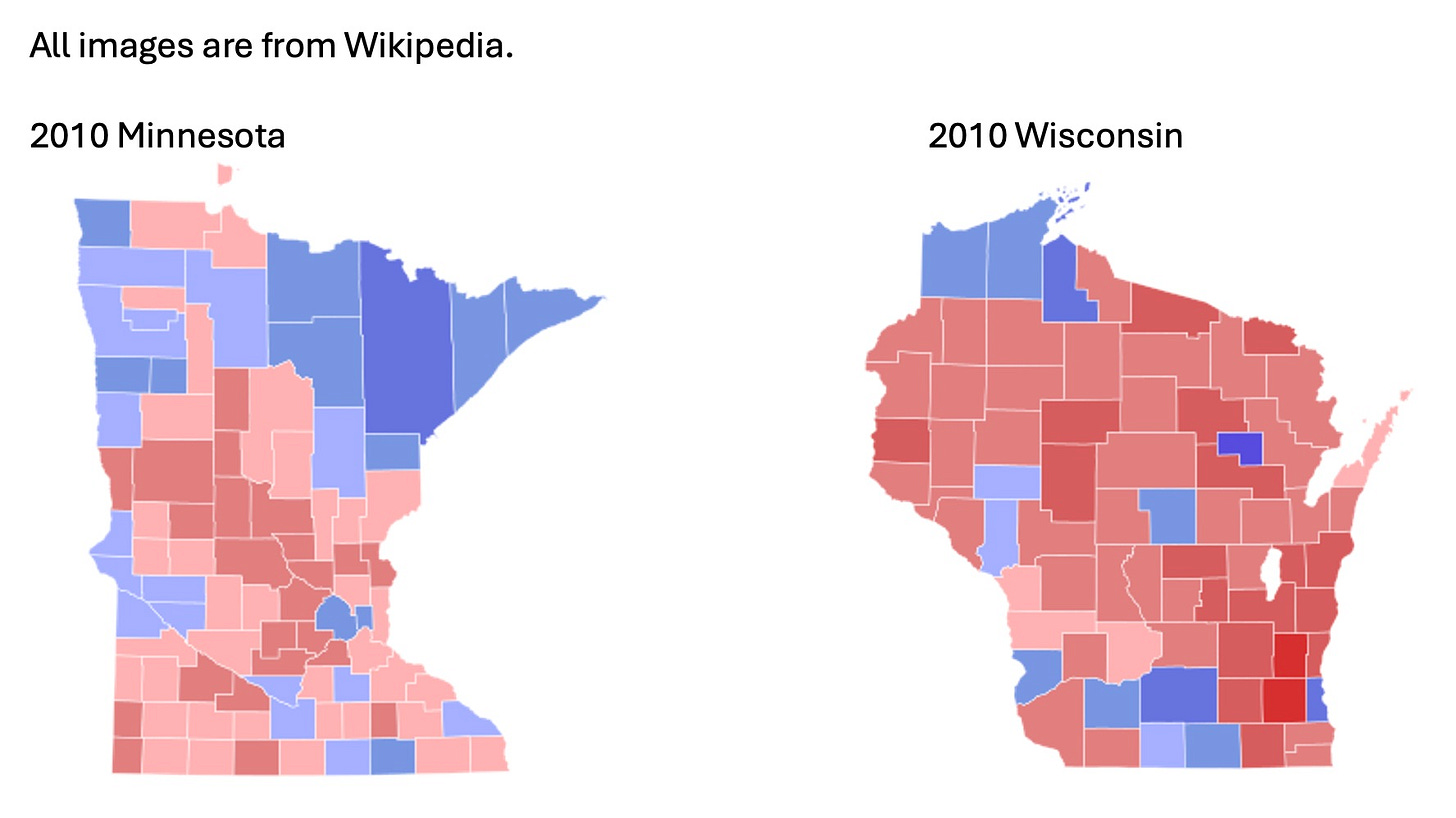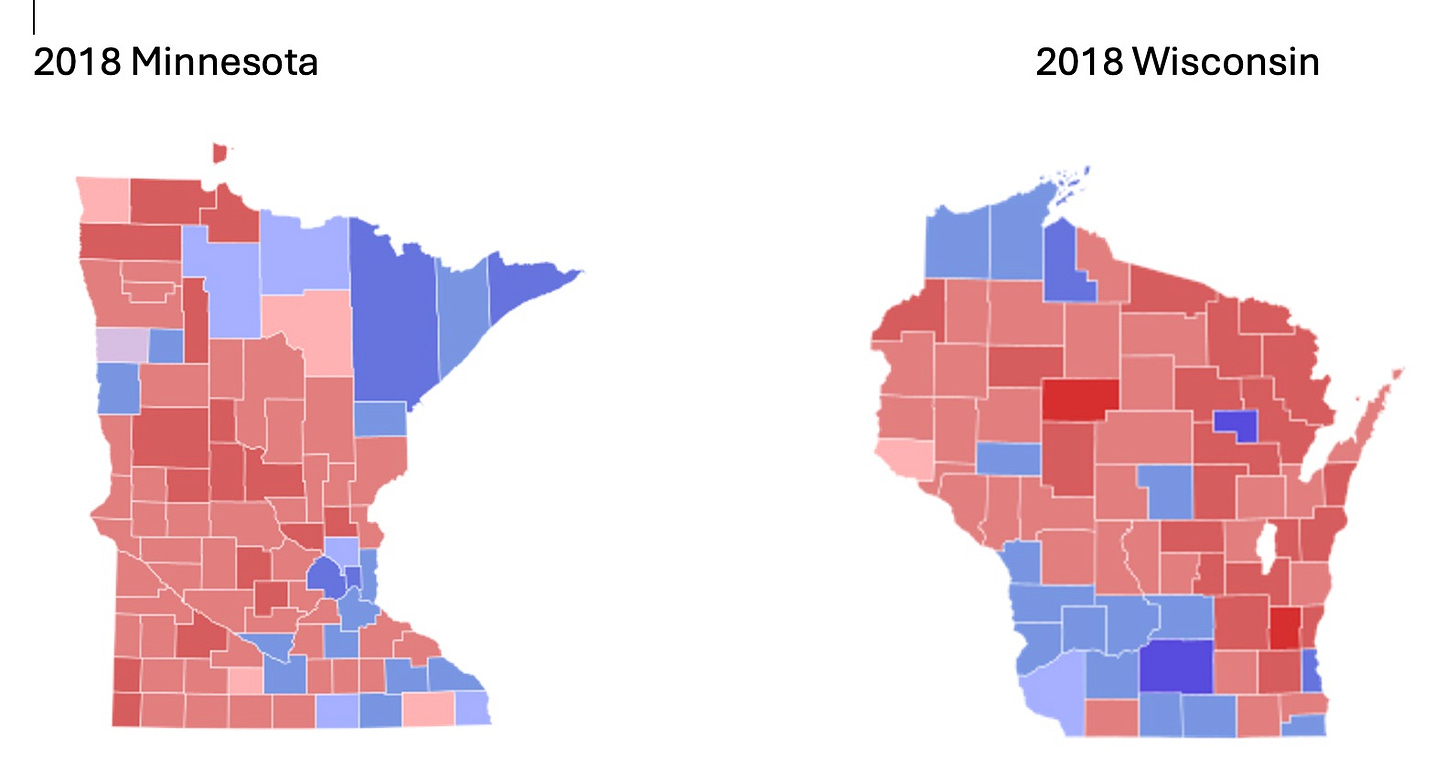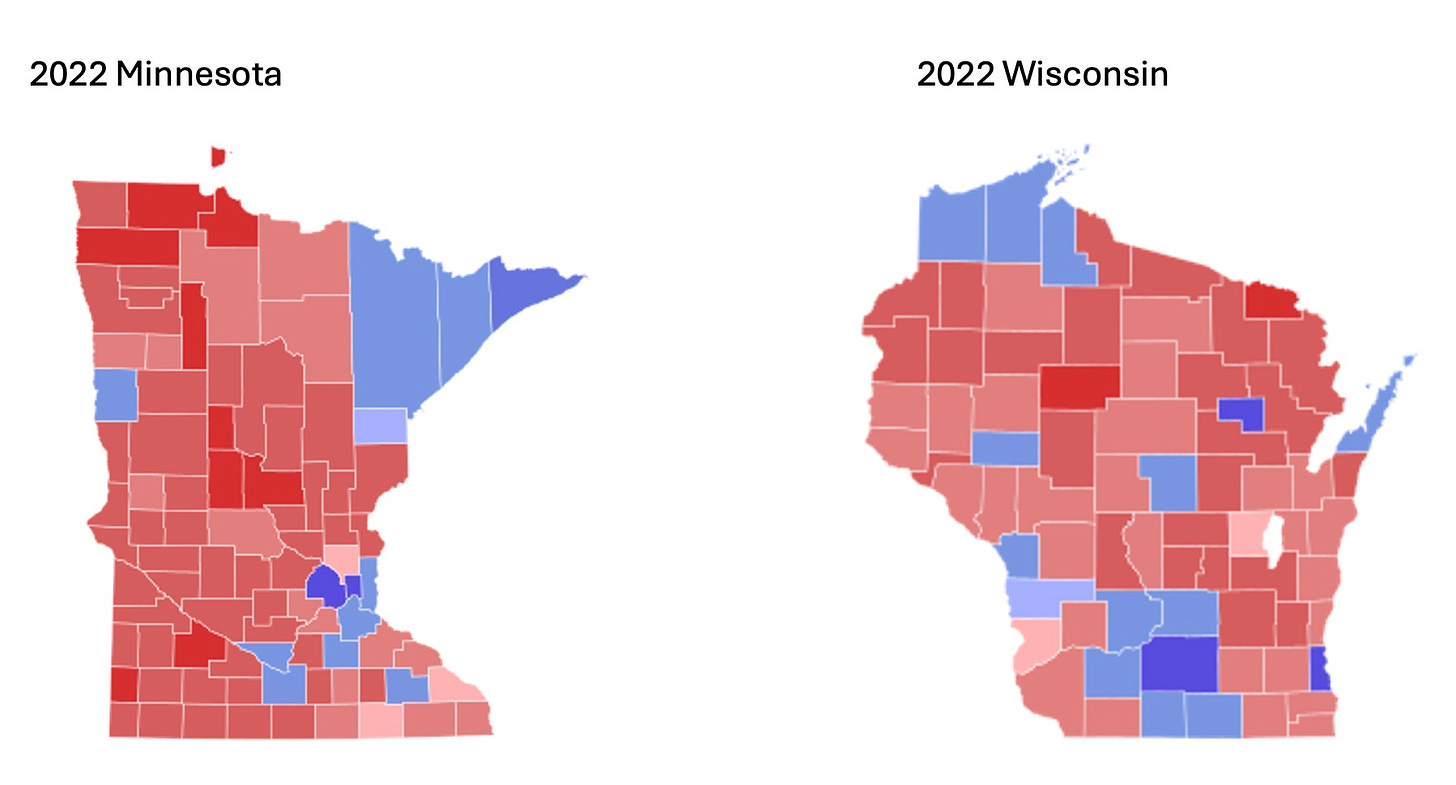Introducing The Fluence Brief, a deeper analysis into the inside dynamics of Minnesota’s news and politics. I’m going to test the market and see if there’s an interest in something more analytical and researched on business, industries, and of course politics.
Thanks for reading, grateful for anyone who makes an investment to subscribe. I’m dedicated to make more insightful and data driven than other briefings, or a lack thereof in Minnesota.
Blois
The Fluence Brief – April 26th, 2025
Minnesota and Wisconsin have a love hate relationship — we’re neighbors, sports rivals and have different cultural highlights. However, the political comparison of the two states over the past 15 years sheds light on how recent history can change a state’s politics, and direction.
The resulting contrasts between the two states show how critical redistricting was to the Wisconsin GOP’s dominance, how the Republican party of Minnesota’s various internal challenges is a major issue while Wisconsin didn’t have any such issues. Ultimately, the differentiator was the building of the state DFL and a turnout and financial machine that starting in 2017 became unbeatable statewide.
As we look ahead to 2024, what can we learn from the past 15 years.
In 2010, then State Rep. Tom Emmer lost to then citizen Mark Dayton by 9,000 votes. Independent candidate Tom Horner pulled nearly 12 percent of the vote which was just over 251,000 votes. On the other side of the border, Scott Walker beat Tom Barrett solidly. In both states Republicans took over the legislature.
The Wisconsin GOP trifecta was a foreshadow of the modern Republican MAGA movement, which has its roots in the Tea Party, but also had a flavor of Midwest populism, different from Southern states.
Dayton’s narrow in 2010 victory can be seen as the beginning of the rise of Minnesota’s current DFL statewide dominance. The Republicans that took over the Minnesota House and Senate after the 2010 election created a very clear differentiation between the two parties. The end game of the 2011 session was Dayton stalemating the GOP legislature into a shutdown, which he later folded on.
Starting with the 2010 defeat, the MN GOP party began a slide that they haven’t been able to recover from in statewide elections. The party’s financial problems and other distractions became an issue, and in 2014 a crowded GOP field for Governor didn’t produce the best most well-funded competitor to Dayton.
All images are from Wikipedia.
Despite the GOP majorities in the MN legislature after 2010, DFLers won back legislature in 2012. Republicans won back the House in 2014, and the Senate in 2016. While control of each body flipped back and forth, DFLers domination through the Dayton terms let created a very challenging environment for Republicans to win statewide.
Donald Trump arrived in 2016, and Republicans initially benefited. However the map of Minnesota changed to a more polarized one, and Republicans began to lose in more suburban areas.
That was foreshadowed by a conversation with then DFL Chair Ken Martin in 2017 anticipating an open Governor’s race yielded the DFL strategy, they no longer needed to win in rural Minnesota. If they organized and invested in the metro area, they would have success if they had higher turnout in the core counties.
That proved true with the Walz victory in 2018. Similarly in Wisconsin, Gov. Tony Evers won in 2018 but had a fully Republican legislature. That was strengthened due to the redistricting after the 2010 Census in Wisconsin, which gerrymandered a very good map for Republicans.
Minnesota’s 2010 census redistricting maps were generally bipartisan, which kept competitiveness in legislative seats.
The other key shift since 2010 was the Minnesota’s Congressional seats became less competitive and evenly split since then. The split is again evident by major shifts between suburban seats and rural seats. This is clearly the most illustrative example of the rural-urban divide.
Beginning in 2018, and trending in 2020 and confirmed in 2024 elections. Consider that it was over the past 10 years that Rep. Collin Peterson held CD7 and Rep. John Kline and Rep Jason Lewis held CD2. For one 2-year period Republicans held CD8, when Rep. Chip Cravaack defeated Rep. Jim Oberstar, but in 2012 Rep. Rick Nolan beat Cravaack after one term. Now Rep. Pete Stauber comfortably holds the seat. Republicans of course have dominated CD1, where Gov. Tim Walz used to serve.
Trump’s first term changed the politics of Minnesota’s CD3, overnight. The moderate Republican district and shifted it toward the DFL in 2018 faster than nearly any other district in the country.
Rep. Angie Craig’s growing strength in CD2, and the lack of a competitive CD3 race in 2024 showed a more permanent shift in the Trump era to suburbs of Minnesota.
Post-COVID and George Floyd Republicans had as strong of a chance as any in 2022 to win a statewide race, but the turnout machine the DFL built, and the decline of turnout for Republicans vs Presidential elections proved to be a major factor.
The SCOTUS Dobbs decision gave Democrats an unexpected boost in 2022, and it played out in Minnesota.
Once again, DFLers swept statewide races. The lack deeper and stronger GOP candidate base created a disadvantage for Republicans. In races like that for Attorney General where Attorney General Keith Ellison defeated Republican Jim Schultz by ~21,000 votes a more experienced candidate, a better GOP organization could have been the difference in the race.
While there was a sentiment that Gov. Walz was vulnerable, his fundraising, campaign discipline and the unforced errors of Republican Scott Jensen proved to be not much of a race.
As you look at the Presidential dynamics between Minnesota and Wisconsin since 2016, you’ll see that while Repubicans came as close as ever in Minnesota in 2016 – the reality is that flipping the state in a Presidential race is something you can’t believe is possible until you see it.
However in Wisconsin, the 2020 victory by Biden does illustrate that Democrats thin advantage in statewide races, and 2024 proved that there is a split-ticket segment in each state. As Klobuchar outperformed Biden in Minnesota, in Wisconsin Democratic Sen. Tammy Baldwin won, while Trump also won.
The GOP Trifecta of 2010 for Republicans in Wisconsin gave them an edge in redistricting, and fundraising for their legislative candidates during November general elections. Dayton’s 2010 win prevented Republicans from dominating redistricting in Minnesota, but it was the unforced errors of Republicans in Minnesota that has led to a weak party, and a lack of strong candidates to run statewide.
As we look ahead to 2024, the biggest unknown is Gov. Tim Walz plans for re-election.
For the GOP, having none of their four members of the US House running statewide shows that they may again be hampered for fundraising. The recent change in leadership for the Minnesota GOP seems better at the basics of communication, but the divide within the party with outsider group Action 4 Liberty is sure to make the caucus and state convention a challenge to deliver the best candidates to win statewide.
For the DFL, the open Senate seat will likely lead to a primary. If Walz doesn’t run again, expect a gubernatorial primary too. If Walz does run, there is an stronger chance of third party candidate, one that could potentially self-finance.
Afterall, it was when Tom Horner ran in 2010, that Republicans came as close as they have from winning statewide in nearly 15 years.




